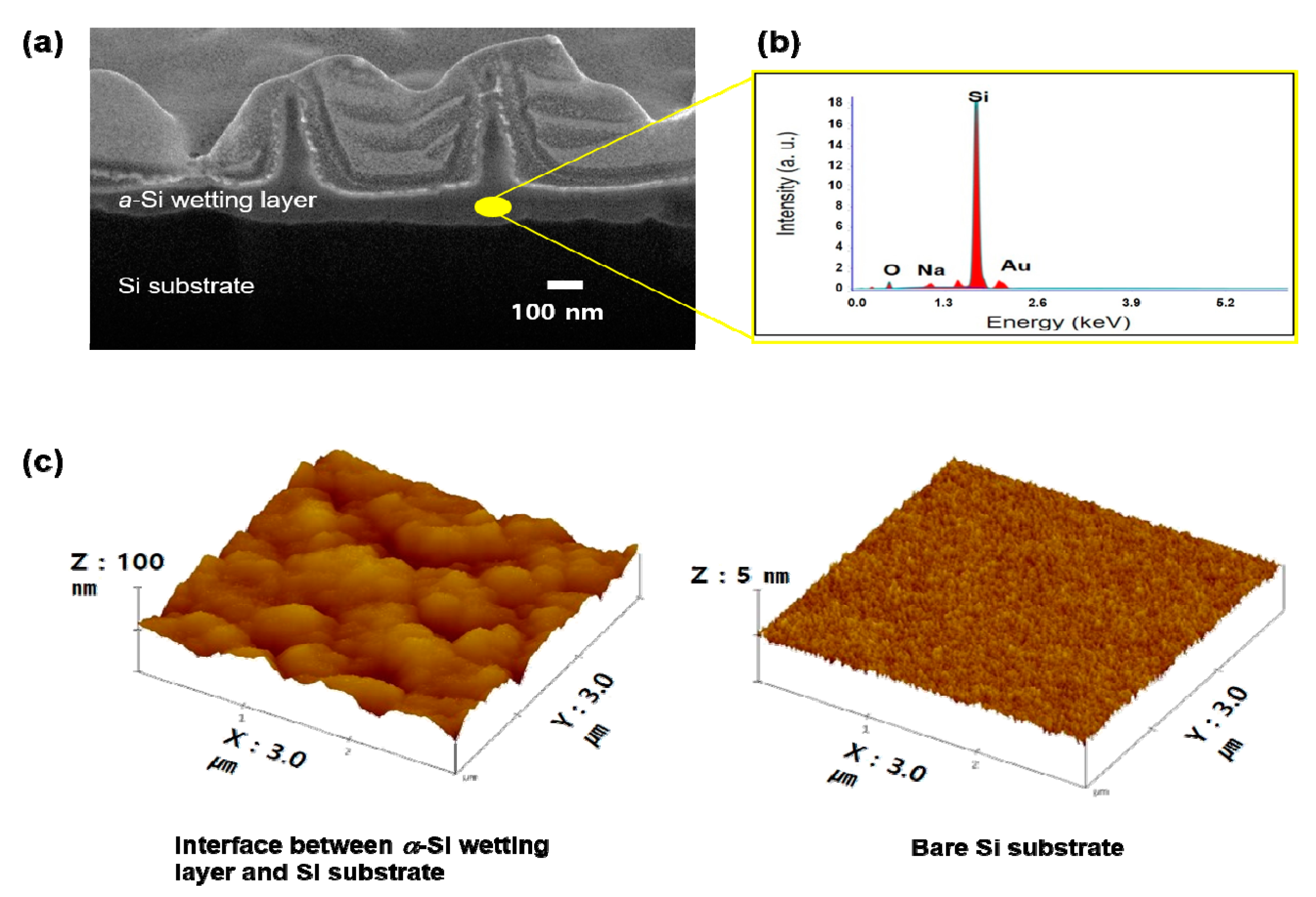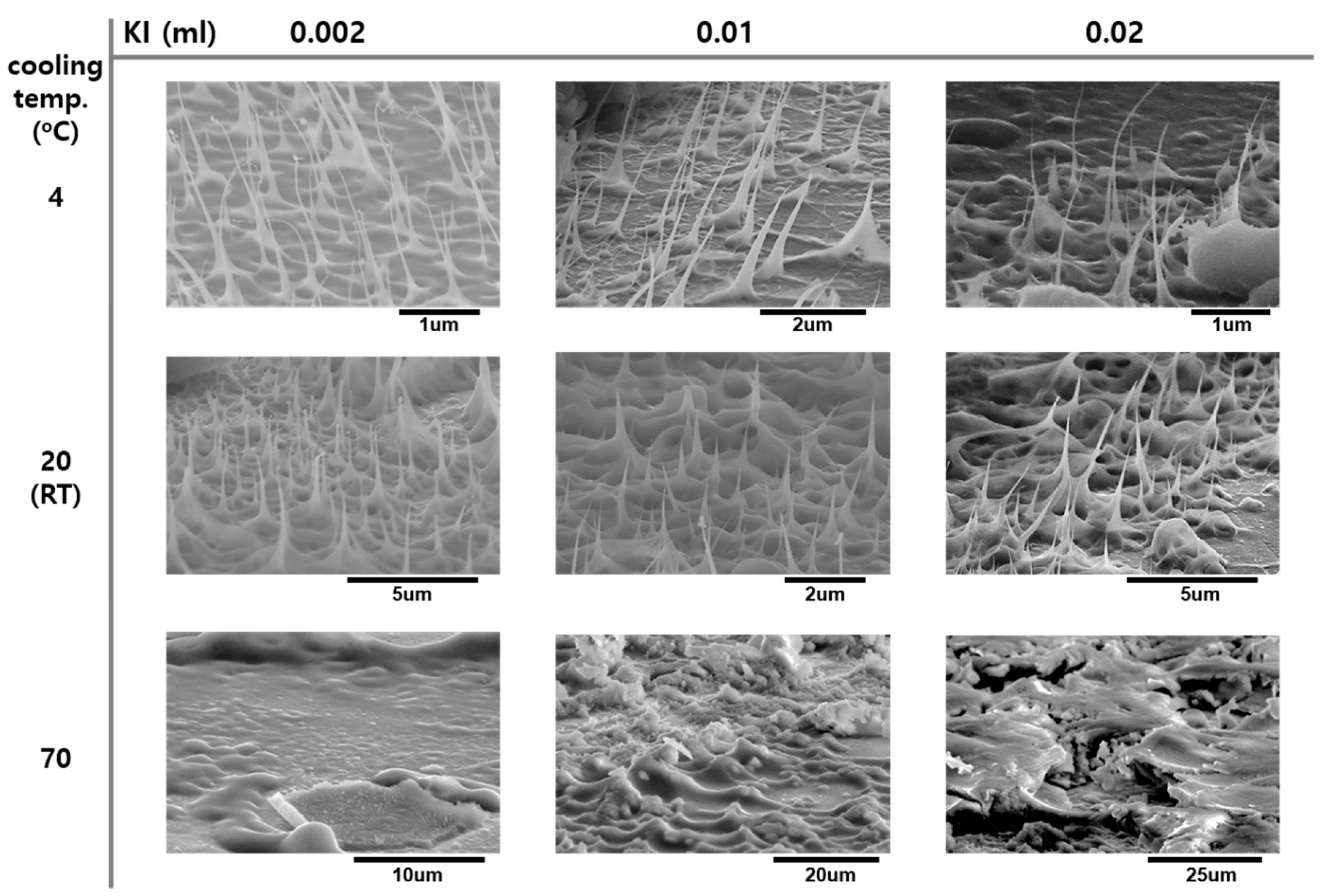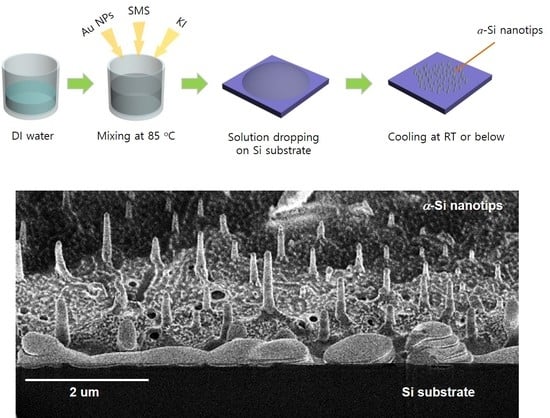Snow-Ice-Inspired Approach for Growth of Amorphous Silicon Nanotips
Abstract
1. Introduction
2. Materials and Methods
3. Results
4. Conclusions
Author Contributions
Funding
Conflicts of Interest
References
- Dasgupta, N.P.; Sun, J.; Liu, C.; Brittman, S.; Andrews, S.C.; Lim, J.; Gao, H.; Yan, R.; Yang, P. 25th anniversary article: Semiconductor nanowires—Synthesis, characterization, and applications. Adv. Mater. 2014, 26, 2137–2184. [Google Scholar] [CrossRef] [PubMed]
- Schmidt, V.; Wittemann, J.V.; Senz, S.; Gösele, U. Silicon nanowires: A review on aspects of their growth and their electrical properties. Adv. Mater. 2009, 21, 2681–2702. [Google Scholar] [CrossRef]
- Priolo, F.; Gregorkiewicz, T.; Galli, M.; Krauss, T. Silicon nanostructures for photonics and photovoltaics. Nat. Nanotechnol. 2014, 9, 19–32. [Google Scholar] [CrossRef]
- Iijima, S.; Ichihashi, T. Single-shell carbon nonatubes of 1-nm diameter. Nature 1993, 363, 603–605. [Google Scholar] [CrossRef]
- Moore, K.E.; Tune, D.D.; Flavel, B.S. Double-Walled Carbon Nanotube Processing. Adv. Mater. 2015, 27, 3105–3137. [Google Scholar] [CrossRef] [PubMed]
- Greene, L.E.; Law, M.; Goldberger, J.; Kim, F.; Johnson, J.C.; Zhang, Y.; Saykally, R.J.; Yang, P. Low-temperature wafer-scale production of ZnO nanowire arrays. Angew. Chem. Int. Ed. 2003, 42, 3031–3034. [Google Scholar] [CrossRef] [PubMed]
- Xu, J.; Chen, Z.; Zapien, J.A.; Lee, C.-S.; Zhang, W. Surface engineering of ZnO nanostructures for semiconductor-sensitized solar cells. Adv. Mater. 2014, 26, 5337–5367. [Google Scholar] [CrossRef] [PubMed]
- Zhao, J.-W.; Zhang, Y.-F.; Li, Y.-H.; Su, C.-H.; Song, X.-M.; Yan, H.; Wang, R.-Z. A low cost, green method to synthesize GaN nanowires. Sci. Rep. 2015, 5, 17692. [Google Scholar] [CrossRef]
- Kumaresan, V.; Largeau, L.; Madouri, A.; Glas, F.; Zhang, H.; Oehler, F.; Cavanna, A.; Babichev, A.; Travers, L.; Gogneau, N.; et al. Epitaxy of GaN nanowires on graphene. Nano Lett. 2016, 16, 4895–4902. [Google Scholar] [CrossRef] [PubMed]
- Wang, X.; Liu, Y.; Zhou, X.; Li, B.; Wang, H.; Zhao, W.; Huang, H.; Liang, C.; Yu, X.; Liu, Z.; et al. Synthesis of long TiO2 nanowire arrays with high surface areas via synergistic assembly route for highly efficient dye-sensitized solar cells. J. Mater. Chem. 2012, 22, 17531–17538. [Google Scholar] [CrossRef]
- Wu, W.-Q.; Xu, Y.-F.; Su, C.-Y.; Kuang, D.-B. Ultra-long anatase TiO2 nanowire arrays with multi-layered configuration on FTO glass for high-efficiency dye-sensitized solar cells. Energy Environ. Sci. 2014, 7, 644–649. [Google Scholar] [CrossRef]
- Alabi, T.R.; Yuan, D.; Bucknall, D.; Das, S. Silicon oxide nanowires: Facile and controlled large area fabrication of vertically oriented silicon oxide nanowires for photoluminescence and sensor applications. ACS Appl. Mater. Interfaces 2013, 5, 8932–8938. [Google Scholar] [CrossRef]
- Yoo, S.; Lee, J.I.; Shim, M.; Park, S. Large-scale synthesis of interconnected Si/SiOx nanowire anodes for rechargeable lithium-ion batteries. ChemSusChem 2013, 6, 1153–1157. [Google Scholar] [CrossRef] [PubMed]
- Li, Y.; Qian, F.; Xiang, J.; Lieber, C.M. Nanowire electronic and optoelectronic devices. Mater. Today 2006, 9, 18–27. [Google Scholar] [CrossRef]
- Wang, N.; Cai, Y.; Zhang, R.Q. Growth of nanowires. Mater. Sci. Eng. R 2008, 60, 1–51. [Google Scholar] [CrossRef]
- Holmes, J.D.; Johnston, K.P.; Doty, R.C.; Korgel, B.A. Control of thickness and orientation of solution-grown silicon nanowires. Science 2000, 287, 1471–1473. [Google Scholar] [CrossRef] [PubMed]
- Schmitt, S.W.; Schechtel, F.; Amkreutz, D.; Bashouti, M.; Srivastava, S.K.; Hoffmann, B.; Dieker, C.; Spiecker, E.; Rech, B.; Christiansen, S.H. Nanowire arrays in multicrystalline silicon thin films on glass: A promising material for research and applications in nanotechnology. Nano Lett. 2012, 12, 4050–4054. [Google Scholar] [CrossRef]
- Kato, S.; Kurokawa, Y.; Miyajima, S.; Watanabe, Y.; Yamada, A.; Ohta, Y.; Niwa, Y.; Hirota, M. Improvement of carrier diffusion length in silicon nanowire arrays using atomic layer deposition. Nanoscale Res. Lett. 2013, 8, 361. [Google Scholar] [CrossRef] [PubMed]
- Park, N.-M.; Choi, C.-J. Growth of silicon nanowires in aqueous solution under atmospheric pressure. Nano Res. 2014, 7, 898–902. [Google Scholar] [CrossRef]
- Berg, W.F. Crystal growth from solutions. Proc. R. Soc. Lond. A 1938, 164, 79–95. [Google Scholar]
- Yuan, L.; Wang, C.; Cai, R.; Wang, Y.; Zhou, G. Temperature-dependent growth mechanism and microstructure of ZnO nanostructures grown from the thermal oxidation of zinc. J. Cryst. Growth 2014, 390, 101–108. [Google Scholar] [CrossRef]
- Libbrecht, K.G. The physics of snow crystals. Rep. Prog. Phys. 2005, 68, 855–895. [Google Scholar] [CrossRef]
- Barrett, J.W.; Garcke, H.; Nürnberg, R. Numerical computations of faceted pattern formation in snow crystal growth. Phys. Rev. E 2012, 86, 011604. [Google Scholar] [CrossRef]
- Nishikawa, H.; Shiroyama, T.; Nakamura, R.; Ohki, Y.; Nagasawa, K.; Hama, Y. Photoluminescence from defect centers in high-purity silica glasses observed under 7.9-eV excitation. Phys. Rev. B 1992, 45, 586–591. [Google Scholar] [CrossRef]
- Liao, L.-S.; Bao, X.-M.; Zheng, X.-Q.; Li, N.-S.; Min, N.-B. Blue luminescence from Si+-implanted SiO2 films thermally grown on crystalline silicon. Appl. Phys. Lett. 1996, 68, 850–852. [Google Scholar] [CrossRef]






© 2019 by the authors. Licensee MDPI, Basel, Switzerland. This article is an open access article distributed under the terms and conditions of the Creative Commons Attribution (CC BY) license (http://creativecommons.org/licenses/by/4.0/).
Share and Cite
Jo, S.; Kim, H.; Park, N.-M. Snow-Ice-Inspired Approach for Growth of Amorphous Silicon Nanotips. Nanomaterials 2019, 9, 680. https://doi.org/10.3390/nano9050680
Jo S, Kim H, Park N-M. Snow-Ice-Inspired Approach for Growth of Amorphous Silicon Nanotips. Nanomaterials. 2019; 9(5):680. https://doi.org/10.3390/nano9050680
Chicago/Turabian StyleJo, Seungil, Hyunsoo Kim, and Nae-Man Park. 2019. "Snow-Ice-Inspired Approach for Growth of Amorphous Silicon Nanotips" Nanomaterials 9, no. 5: 680. https://doi.org/10.3390/nano9050680
APA StyleJo, S., Kim, H., & Park, N.-M. (2019). Snow-Ice-Inspired Approach for Growth of Amorphous Silicon Nanotips. Nanomaterials, 9(5), 680. https://doi.org/10.3390/nano9050680




